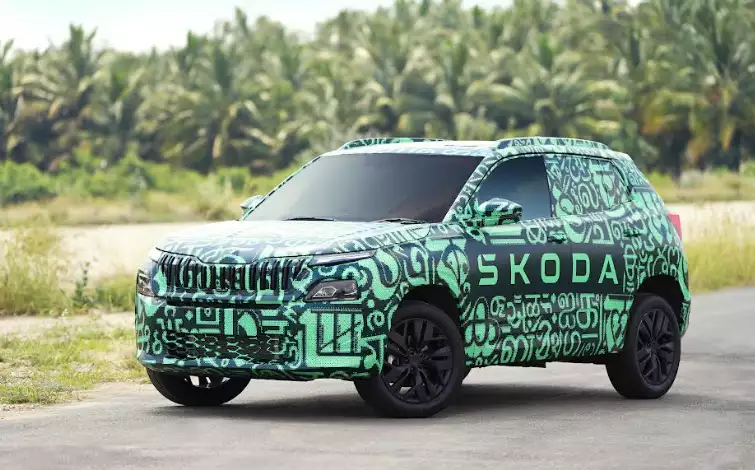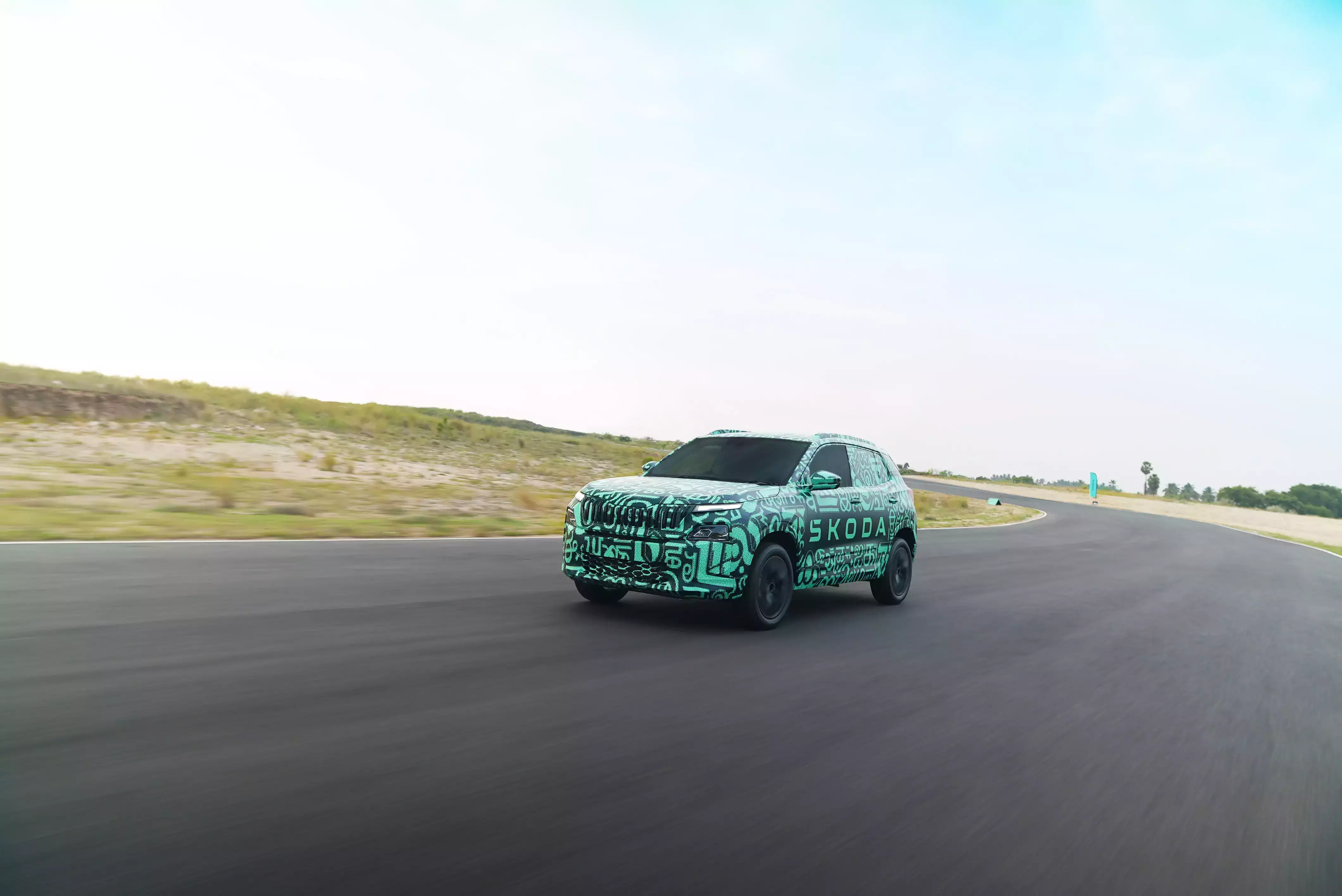 Skoda Kylaq Coimbatore:
Skoda Kylaq Coimbatore: Skoda Auto Volkswagen India (SAVW) got some much needed traction in the Indian passenger vehicle market with the Skoda Kushaq SUV, Slavia sedan, and their VW twins, launched starting June 2021 under Volkswagen’s Group’s ‘India 2.0’ strategy. WIth the Skoda Kylaq, the European Group’s ambition is to gain a much better presence in India. After all, it will play in a segment which alone contributes around 30% of India’s passenger vehicle (PV) industry volumes.
The compact SUV is slated for a ‘global unveil’ on 6th November, followed by the commercial launch in February ‘25. SAVW has dedicated 100,000 units annual production in its Chakan plant, where the installed capacity has recently been hiked to 255,000 units per year
 Skoda Kylaq
Skoda Kylaq
Next phase of engineering in India
The Kylaq, which shares the MQB-A0-IN platform with the Kushaq and Slavia, has a distinction of being the first VW Group model whose top hat, or the body shell, has been designed and engineered in India. With this as the first-of-its kind “major step”, the VW Group is looking at tapping the India Technical Centre, and the inherent strengths of Indian engineers, for bigger projects.
 Piyush Arora, MD and CEO, Skoda Auto Volkswagen India
Piyush Arora, MD and CEO, Skoda Auto Volkswagen India “One step is taking over more product development for India responsibility. And, secondly what we are also looking at is how Indian engineering capacities can also participate in our global programs, and that is a development process which we have just started,” Piyush Arora, MD and CEO, Skoda Auto Volkswagen India.
In an increasingly technology intensive industryscape, no one OEM can tackle all the challenges, even if it is someone like Volkswagen. Therefore, the European major is also looking at what more work can be done “together with the engineering service providers also”.
The VW Group set up its first India Technical Centre, in Chakan, 5 years ago. It also has an IT services organisation, which, apart from developing or supporting VW’s global operations for business software, is also looking at product development. Some of the engineering work is “also happening via Cariad”. Cariad, VW’s software technology arm, also has some other partners for tech development in India.
“We are evaluating the possibilities of how we can utilise our Technical Centre to also collaborate with other engineering companies in India, who then can also participate in our global programmes,” says Arora. He also says that the learnings from developing the MQB-A0-IN platform are also being implemented to enhance the company’s manufacturing, and supply chain processes.
The TCO challenge
Local development of models can also help them to have lower cost of ownership. And, relatively higher ownership or maintenance costs have been a barrier for Indian customers to go for a Skoda, or a VW model. But that has changed, argues Arora. He says, “I think we brought down the total cost of ownership by a great deal with India 2.0 itself, with a high degree of localisation. We are extremely competitive in our segment, but our communication has to reach out to the customers.” Arora sees a chance to drive home the point with the Kylaq, which will sit in the biggest segment of the Indian PV industry, with customers who may be more price and maintenance cost sensitive.
More models to come
The SUV Kylaq may remain as the only sub-4 metre (3995mm) model in Skoda Auto India’s portfolio for some time at least, but the Skoda, and the VW range in India is likely to be expanded. “Our aspiration is to address more segments, and we are in the process of evaluating which other segment,” says Arora.
50% of the Indian PV market is still untapped by SAVW because of its relatively small model range. With the developed in India models, with Kylaq as the lead driver, it hopes to scale up its current combined market share of around 3% in India.
And, work on tapping Right Hand Drive export markets with these models is also ongoing. Vietnam is the first market which will see assembly operations of the MQB-A0-IN platform products, starting early next year. And, Kaylaq is said to be attracting some interest as well. ASEAN markets like Indonesia and Thailand are also in the radar.
In India, the Kylaq is expected to do something like what the Kia Sonet did for its maker. The Skoda Kylaq will be the eighth model in the compact SUV segment, and will face some formidable competition in the likes of Tata Nexon, Maruti Brezza, and the Kia Sonet too. However, Skoda Auto is bullish of a good performance “even if the segment gets more crowded”.
 Petr Janeba, Skoda Auto India’s Brand Director
Petr Janeba, Skoda Auto India’s Brand Director Petr Janeba, Skoda Auto India’s Brand Director believes the segment’s growth will help the Czech brand to gain some good space. “The segment, between 2020 to 2025, will grow massively. It's already grown more than 100%, and the segment potential is much bigger,” he told
ETAuto.
SAVW is betting on safety as a major selling point for the Kaylaq. It claims the hot-formed steel crash module is the best-in-segment, ensuring higher cabin safetyand integrity. The Kaylaq will be the first model from the SAVW stable to undergo the Bharat NCAP (New Car Assessment Programme) crash test. Its bigger sibling Kushaq has earlier secured a 5-star rating in a Global NCAP crash test.
Jiří Dytrych, Head of Product Development, Skoda Auto, says that apart from the safety aspect, space and comfort were the key focus areas for the Kaylaq." The Kaylaq will offer first-in-class six-way adjustable driver and passenger seats with ventilation function.” With such creature comforts, and equipped with a turbocharged 1.0 litre engine, the Kaylaq has a major responsibility to lead Skoda Auto’s charge to achieve the 100,000 units sales target it has set to achieve in 2025. Will it deliver? The customer will deliver the ultimate verdict, starting February.



